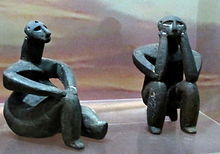Hamangia culture
Because of its ceramic decoration, the Hamangia culture was initially thought to be an offshoot of the Mediterranean cardial or imprint culture . It is more likely, however, to have indigenous roots, as suggested by the early Hamangia pottery, which is related to Starčevo-Körös-Cris shapes, and the microlithic flint industry known from earlier times in the area. With the help of the comparative chronology and the radiocarbon dating it could be dated to the 6th and 5th millennia (before 4700 BC).
Find places and chronology
Half-sunken dwellings, such as that of Golovita near Baia Hamangia , were found on river terraces or on the banks of the lake. The cultural development was described differently. There are systematics with five, four or three main phases, which roughly correspond to the Boian culture (Romania) and Karanovo III-IV-V (Bulgaria) between 5500 and 4700 (Romania) or 4500 (Bulgaria). The end of the Hamangia culture with the outcome of stage III is assumed by Romanian research. In Bulgaria, based on the findings of Durankulak , research believes that it can still prove an IV stage. Essentially, however, this level IV is already material from the following Varna group . There is only one radiocarbon dating for Hamangia III, which due to the high standard deviation, the settlement phase to only roughly between 5000 and 4500 BC. Chr. (Calibrated). The cemetery at Cernavodǎ near the Danube contained around 600 body burials, 400 of which were excavated. One or two vessels, a polished stone tool, and a few clay or marble figures were found in women's and men's graves. Most of them in the upper part of the burial ground, which is believed to be younger. Half-round, round, and diamond-shaped pebbles were often found in the head area of the dead. In many cases later burials lay on top of earlier ones, or earlier bones had been removed and buried again with the new ones. To the west and north of the burial ground, ritual burials of skulls along with the remains of a feast were discovered in several places. Next to the graves were the skulls and lower jaws of deer, pigs, cattle and goats. The separate burial of skulls could indicate secondary burial. The excavation at Durankulak by Henrietta Todorova and Todor Dimov brought the discovery of sunk pit dwellings and 846 graves from different phases as well as a settlement from the following Varna period . They show a continuity of the site through three quarters of the 5th millennium.
art
The Hamangia culture developed its own style, which is evident in black-polished pottery, which is decorated with white encrusted triangles, meanders and zigzag lines, as well as in individualistic terracotta and marble figures. Female sculptures have been found lying on their backs in graves. There are also standing or sitting lush female figures with columnar heads without facial features. A male and a female terracotta idol were found in a grave in Cernavodǎ; both are shown masked, seated and naked. They are about 12 cm high, made of carefully polished, gray-brown clay. The man is sitting on a stool with his chin in both hands, the woman has both hands on her right knee. The man is one of the most famous works of art of the European Aeneolithic . He has been named "the thinker" after Auguste Rodin's sculpture. In addition to the predominant sculptures in graves, the type of pregnant woman was also found in villages. An above-ground house was excavated in the Golovita settlement. It was 6 × 5 meters and seems to have served as a place of worship. Four pregnant terracottas, hands on belly, lay on the floor.
The "Hamangia region" in which the culture developed rapidly was, with one exception, a steppe region between the Neolithic centers of the Danube region and the climatically favored Thrace . Later it went on in the Gumelnitza culture . Characteristics include figurines such as the terracottas from Cernavodă (Romania).
literature
- Glyn Daniel : Encyclopedia of Archeology ("The illustrated encyclopedia of archeology"). Verlag Nikol, Hamburg 1996, ISBN 3-930656-37-X (reprint of the Herrsching edition 1980).

